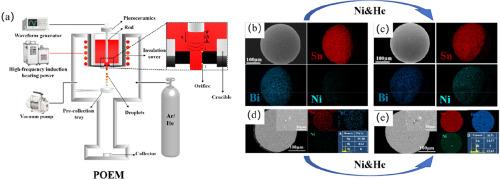脉动孔喷射法制备Sn20Bi-xNi钎料球及其微接头性能
IF 4.6
2区 工程技术
Q2 ENGINEERING, CHEMICAL
引用次数: 0
摘要
由于其优异的焊接特性和潜在的成本优势,特别是在高密度封装应用中,锡铋基合金是传统锡铅焊料的理想无铅替代品。在本研究中,采用脉冲孔喷射法(POEM)成功制备了直径250 μm的Sn20Bi-xNi (x = 0,0.4, 0.8 wt%) BGA焊料球。快速冷却(104 K/s)和Ni微合金化相结合,有效地缓解了Bi偏析,获得了球状性好、粒度分布窄(标准差为1.8 μm)、组织均匀细化的钎料球。冷却速率显著影响表面形貌:在103 K/s下形成枝晶结构,而在104 K/s下形成细胞/等轴晶体。Ni的加入抑制了枝晶的生长,并通过协同快速氦气冷却获得了光滑、无偏析的表面。所开发的焊料体系表现出优异的性能:最小熔化范围为14.4°C,显著提高润湿性(接触角低至22°),降低金属间化合物(IMC)厚度(1.20 μm),抗剪强度高达60.1 MPa。这些高性能poem制备的焊料球在BGA封装中具有显著的应用潜力,具有明显的实现优势。本文章由计算机程序翻译,如有差异,请以英文原文为准。

Preparation of Sn20Bi-xNi solder balls by pulsated orifice ejection method and their micro joint properties
Sn-Bi based alloys represent ideal lead-free substitutes for conventional Sn-Pb solders due to their excellent soldering characteristics and potential cost advantages, particularly in high-density packaging applications. In this study, 250 μm diameter Sn20Bi-xNi (x = 0, 0.4, 0.8 wt%) BGA solder balls were successfully fabricated using the pulsated orifice ejection method (POEM). The combination of rapid cooling (104 K/s) and Ni microalloying effectively mitigated Bi segregation, yielding solder balls with excellent sphericity, narrow particle size distribution (standard deviation <1.8 μm), and uniformly refined microstructure. Cooling rate significantly influenced surface morphology: dendritic structures formed at 103 K/s, while cellular/equiaxed crystals develop at 104 K/s. Ni addition suppressed dendritic growth, and smooth, non-segregated surfaces were achieved through the synergistic rapid He gas cooling. The developed solder system exhibited exceptional performance: minimum melting range of 14.4 °C, significantly enhanced wettability (contact angles as low as 22°), reduced intermetallic compound (IMC) thickness (1.20 μm), and shear strength up to 60.1 MPa. These high-performance POEM-prepared solder balls demonstrate significant application potential in BGA packaging, offering distinct implementation advantages.
求助全文
通过发布文献求助,成功后即可免费获取论文全文。
去求助
来源期刊

Powder Technology
工程技术-工程:化工
CiteScore
9.90
自引率
15.40%
发文量
1047
审稿时长
46 days
期刊介绍:
Powder Technology is an International Journal on the Science and Technology of Wet and Dry Particulate Systems. Powder Technology publishes papers on all aspects of the formation of particles and their characterisation and on the study of systems containing particulate solids. No limitation is imposed on the size of the particles, which may range from nanometre scale, as in pigments or aerosols, to that of mined or quarried materials. The following list of topics is not intended to be comprehensive, but rather to indicate typical subjects which fall within the scope of the journal's interests:
Formation and synthesis of particles by precipitation and other methods.
Modification of particles by agglomeration, coating, comminution and attrition.
Characterisation of the size, shape, surface area, pore structure and strength of particles and agglomerates (including the origins and effects of inter particle forces).
Packing, failure, flow and permeability of assemblies of particles.
Particle-particle interactions and suspension rheology.
Handling and processing operations such as slurry flow, fluidization, pneumatic conveying.
Interactions between particles and their environment, including delivery of particulate products to the body.
Applications of particle technology in production of pharmaceuticals, chemicals, foods, pigments, structural, and functional materials and in environmental and energy related matters.
For materials-oriented contributions we are looking for articles revealing the effect of particle/powder characteristics (size, morphology and composition, in that order) on material performance or functionality and, ideally, comparison to any industrial standard.
 求助内容:
求助内容: 应助结果提醒方式:
应助结果提醒方式:


